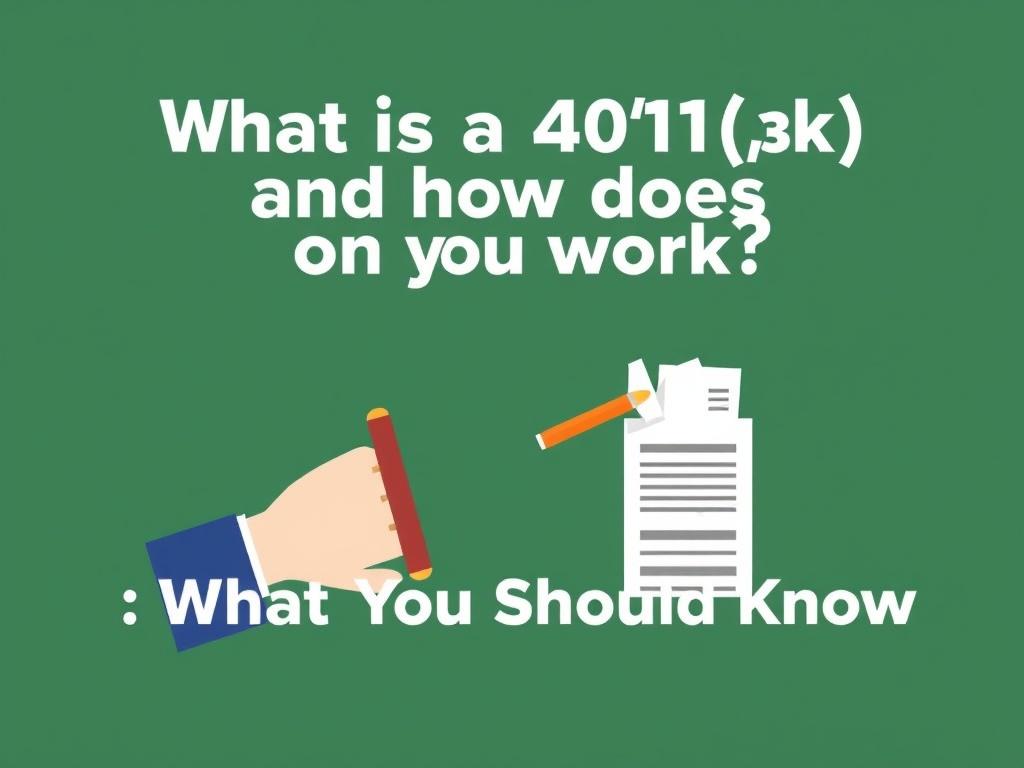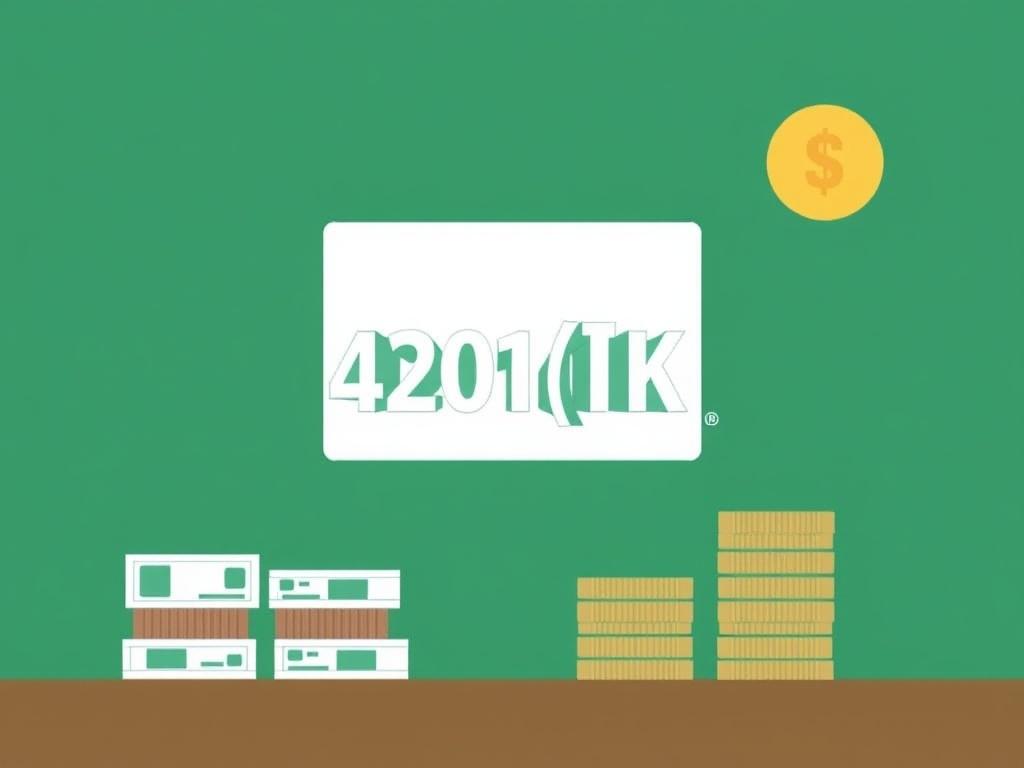SQLITE NOT INSTALLED
When it comes to planning for retirement, the term “401(k)” pops up everywhere, but what exactly is a 401(k), and how does it work? Whether you’ve just started your first job or are well into your career, understanding the ins and outs of a 401(k) can have a huge impact on your financial future. This article breaks down everything you need to know about 401(k) plans in a straightforward, easy-to-understand way, so you can make smart decisions for your retirement.
At its core, a 401(k) is a retirement savings plan sponsored by your employer. It’s designed to help you save and invest money for your future retirement years efficiently. But unlike a simple savings account, a 401(k) comes with some powerful tax advantages and potential matching contributions that can significantly boost your savings over time. Let’s dive deeper into how exactly a 401(k) works and why it might be one of the best tools you have for retirement planning.
Содержание
What Exactly Is a 401(k)? The Basics Explained
A 401(k) is a type of defined-contribution retirement plan that many employers offer to their employees. The name “401(k)” actually comes from the section of the U.S. Internal Revenue Code that created this Plan — section 401(k). Simply put, it allows employees to save part of their paycheck into a special retirement account before taxes are taken out.
This is important because the money you contribute to your 401(k) isn’t immediately taxed. That means you are taxed on the money later when you withdraw it during retirement, ideally when you’re in a lower tax bracket. That’s why many people refer to 401(k)s as tax-deferred retirement plans. But some employers also offer something called a Roth 401(k), where the taxes are paid upfront, and withdrawals in retirement are tax-free.
How Contributions Work
With a 401(k), you decide how much money you want to defer from each paycheck. Generally, you choose a percentage or a fixed amount, and that money is automatically deducted from your paycheck and deposited into your 401(k) account. Employers usually set a yearly limit on how much you can contribute; for 2024, the IRS allows employees to contribute up to $23,000 annually if you’re under 50, and up to $30,500 if you’re 50 or older (due to catch-up contributions).
Employer Match: Free Money for Your Retirement
One of the biggest advantages of a 401(k) plan is the potential employer match. Many employers offer to “match” a portion of your contributions—this means free money added to your retirement savings just for participating. For example, an employer might match 50% of your contribution up to 6% of your salary. So if you contribute 6%, your employer adds 3%. This is essentially an immediate 50% return on that portion of your contributions, which is hard to beat with other investments.
Types of 401(k) Plans
Before you get started, it’s good to understand that not all 401(k) plans are the same. Employers can offer a few different types, each with its own features. Here are the main types you might encounter:
- Traditional 401(k): Contributions are made pre-tax, helping reduce your taxable income now, but taxes are due when you withdraw funds in retirement.
- Roth 401(k): Contributions are made with after-tax dollars, which means you pay taxes now, but qualified withdrawals in retirement are tax-free.
- Safe Harbor 401(k): Designed to help employers meet certain IRS requirements, often involves mandatory employer contributions, making it easier for employees to fully vest in funds quickly.
- SIMPLE 401(k): For smaller companies, simpler to administer, with lower contribution limits but generally mandatory employer matching.
Traditional vs. Roth 401(k): Which Is Better?
Deciding between a Traditional and a Roth 401(k) can feel tricky. The choice largely depends on your current tax situation and expectations for your future tax brackets. If you anticipate being in a lower tax bracket after you retire, a Traditional 401(k) might provide bigger tax benefits upfront. However, if you believe your income — and thus your tax rate — will be higher later, a Roth 401(k) might be more advantageous since withdrawals are tax-free.
Investing Your 401(k) Contributions: What Are Your Options?
A 401(k) isn’t just a place to park your money—it’s a powerful investment vehicle. When you contribute, the money goes into investment funds chosen by your employer or the plan administrator. You can usually pick from a variety of mutual funds, including stock funds, bond funds, and often target-date funds, which automatically adjust your asset allocation based on your expected retirement date.
Understanding the Different Investment Choices
Here’s a quick look at some common types of investments within a 401(k):
| Investment Type | Description | Risk Level |
|---|---|---|
| Stock Funds | Funds that invest primarily in shares of companies, offering growth potential but also higher volatility. | High |
| Bond Funds | Funds investing in debt securities, tend to be less volatile than stocks but generally offer lower returns. | Medium |
| Target-Date Funds | Automatically shift the mix of stocks and bonds over time to reduce risk as retirement nears. | Varies (shrinks over time) |
| Stable Value or Money Market Funds | Low-risk investments designed to preserve capital while earning modest returns. | Low |
Your investment choices can significantly influence how much money you accumulate by retirement. Many experts recommend focusing on diversification: spreading your money across different types of investments to help manage risk while seeking growth.
How Does Money Grow in a 401(k)? The Power of Compound Interest

One of the most important concepts to understand about a 401(k) is compound interest. Simply put, this means your investment earnings generate their own earnings. Over time, this snowball effect can turn your savings into a substantially larger amount.
Consider this example: If you contribute $5,000 a year to your 401(k) starting in your 20s and earn an average return of 7% per year, by the time you retire at 65, you could have over $1 million saved. The key takeaway is the earlier you start, the better, because compound interest has more time to work its magic.
Contribution Limits and Catch-Up Contributions
To keep your retirement money growing steadily, it’s essential to understand how much you can contribute each year. As mentioned, the IRS sets annual contribution limits. For 2024, the base limit is $23,000, and if you’re 50 or older, you can make an additional “catch-up” contribution of $7,500, bringing the total to $30,500.
Here’s a quick summary:
| Contribution Type | 2024 Contribution Limit |
|---|---|
| Employee contribution (under 50) | $23,000 |
| Employee contribution (50 and older) | $30,500 |
| Employer matching contributions | No legal limit but subject to overall plan limits |
Withdrawal Rules and Penalties: What You Should Know

A key characteristic of 401(k) plans is that they’re designed for long-term retirement savings. To encourage this, early withdrawal rules and penalties exist to discourage using the money before you retire.
When Can You Withdraw Without Penalty?
Generally, 401(k) withdrawals are allowed penalty-free starting at age 59½. If you take money out before that, there is usually a 10% early withdrawal penalty on top of regular income taxes you owe. However, there are some exceptions, like hardship withdrawals, certain medical expenses, or if you become totally disabled, but these have strict rules.
Required Minimum Distributions (RMDs)
The government requires you to start taking minimum withdrawals from your Traditional 401(k) starting at age 73 (as of current rules). These minimum amounts are based on your account balance and life expectancy. Failing to take RMDs can result in heavy tax penalties. For Roth 401(k)s, RMDs are also required, but if you roll over the money into a Roth IRA, you can avoid RMD rules.
How Does a 401(k) Compare to Other Retirement Plans?

Besides 401(k)s, there are other retirement savings options, such as IRAs (Individual Retirement Accounts) and pensions. It helps to understand how a 401(k) stacks up against these alternatives.
| Retirement Plan | Contribution Limits (2024) | Tax Treatment | Employer Contributions | |
|---|---|---|---|---|
| 401(k) | Up to $23,000 ($30,500 if 50+) | Pre-tax (Traditional) or after-tax (Roth) | Often available | Varies by employer |
| Traditional IRA | $7,000 ($8,000 if 50+) | Pre-tax contributions, tax-deferred growth | No | Wide variety |
| Roth IRA | $7,000 ($8,000 if 50+) | After-tax contributions, tax-free withdrawals | No | Wide variety |
| Pension Plan | No personal contributions; employer-funded | Tax-deferred, paid on distributions | Yes, fully employer funded | Typically none (guaranteed benefit) |
Simply put, 401(k) plans are flexible, portable, and often come with the massive advantage of employer matching. IRAs offer more investment options but usually lack employer contributions. Pension plans offer guaranteed income but are becoming rarer in the private sector.
Steps to Get Started With a 401(k) Plan
So, you’re interested in building your retirement savings with a 401(k)? Here’s a step-by-step process to get started:
- Check if your employer offers a 401(k) plan. Not all employers do, but many do, especially larger companies.
- Understand your company’s plan rules. Look into what investment options, contribution limits, and matching programs your employer offers.
- Enroll in the plan. Usually you’ll have to fill out some paperwork or sign up online.
- Decide your contribution amount. A good rule of thumb is to contribute at least enough to get the full employer match—that way, you don’t leave free money on the table.
- Select your investments. Consider your age, risk tolerance, and goals. Many plans offer target-date funds as an easy default.
- Review and adjust regularly. Your financial situation changes over time, so revisit your 401(k) contributions and allocations annually or when you have a life change.
Common Questions About 401(k)s
Let’s address some frequently asked questions about 401(k) plans that might be on your mind:
Can I Withdraw My 401(k) When Changing Jobs?
Yes, you typically have several choices when changing jobs: leave your savings in your old 401(k), roll it over into your new employer’s 401(k), transfer it to an IRA, or cash it out (though cashing out is usually not advised due to taxes and penalties).
What Happens If I Don’t Enroll?
Many employers have automatic enrollment these days, but if yours doesn’t, and you don’t actively enroll, you won’t save through the plan and will miss out on the tax advantages and employer match.
Are Loans Allowed From a 401(k)?
Some plans allow you to borrow from your 401(k), but it depends on the rules set by your plan. Loans have pros and cons, and it’s best to consider them carefully since they can impact your retirement savings growth.
How Is a 401(k) Different From Social Security?
Social Security is a government program that provides you with guaranteed retirement income based on your work history. A 401(k) is a private savings plan you control and fund. Both can be part of your retirement income, but 401(k)s offer you more control and growth potential.
Maximizing Your 401(k) Benefits: Tips for Success
Now that you understand what a 401(k) is and how it works, let’s look at some ways to get the most out of your plan:
- Contribute early and often. The sooner you start contributing, the more time your money has to grow.
- Aim for the employer match. Always contribute at least enough to get the full match if your employer offers it.
- Diversify your investments. Don’t put all your money in one stock or bond fund—spread your investments across different assets.
- Review your plan annually. Check your contributions and investment mix as you get closer to retirement.
- Consider increasing contributions over time. Even small increases can make a big difference in your nest egg.
Building a comfortable retirement takes time, patience, and smart choices with your 401(k) plan. But the good news is that every dollar you save today can make your future retirement years more secure and enjoyable.
Understanding Fees in 401(k) Plans
Fees can unintentionally eat into your 401(k) savings over time, so it’s essential to understand what you might be paying. Common fees include administrative fees, investment management fees, and sometimes individual service fees. While it may seem complex, many plans provide fee disclosures that help you know exactly what you’re paying. Lower fees generally mean more of your money stays invested and growing for retirement.
What If My Employer Does Not Offer a 401(k)? Alternatives
If your employer doesn’t offer a 401(k), don’t worry. You still have options to save for retirement, such as opening an Individual Retirement Account (IRA) or contributing to a Roth IRA, if eligible. These accounts don’t have employer matching, but they still provide tax advantages and a wide range of investment choices. You can also explore self-employed plans like Solo 401(k)s or SEP IRAs if you work for yourself.
Summary of Alternatives
| Plan | Contribution Limits (2024) | Main Benefit |
|---|---|---|
| Traditional IRA | $7,000 ($8,000 if 50+) | Tax-deferred growth with potential upfront tax deductions |
| Roth IRA | $7,000 ($8,000 if 50+) | Tax-free withdrawals in retirement |
| Solo 401(k) | Up to $66,000 depending on income | High contribution limits for self-employed |
| SEP IRA | Up to 25% of compensation or $66,000 | Employer contributions for self-employed or small businesses |
Conclusion
Understanding what a 401(k) is and how it works opens the door to a powerful way to save and invest for your retirement years. From pre-tax contributions to employer matches, investment choices, and tax advantages, a 401(k) gives you a structured path to building your financial future. Whether you’re just starting to save or looking to maximize your current plan, taking full advantage of a 401(k) plan can make a significant difference in reaching your retirement goals. Remember, the key is to start early, contribute consistently, and stay informed—your future self will thank you!
Опубликовано: 23 July 2025 Кредитрон – блог о кредитах, финансах и прочих реверансах
Кредитрон – блог о кредитах, финансах и прочих реверансах

